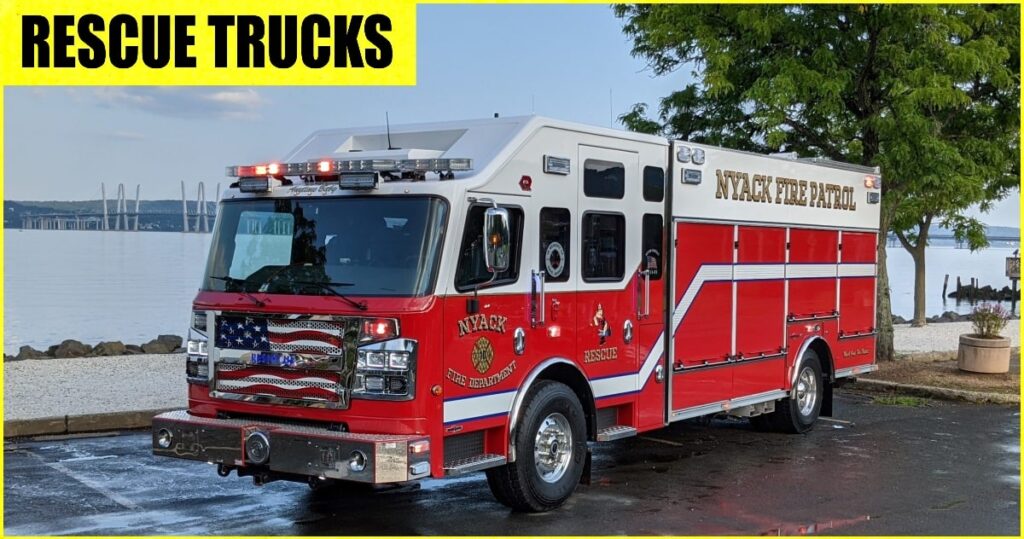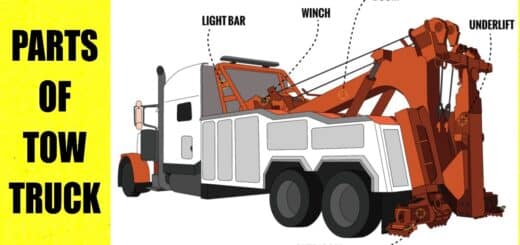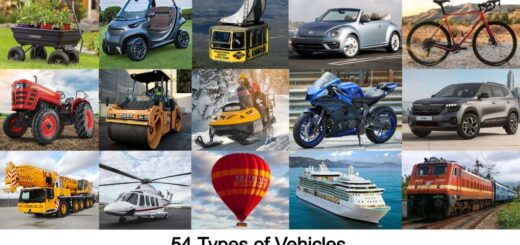Rescue Trucks: Definition, Types, Uses, Specifications, Equipment & Requirements

Rescue Truck Introduction:
Rescue Trucks: Definition, Types, Uses, Specifications, Equipment & Requirements: – Rescue trucks are an essential part of any kind of emergency. These trucks are intended and designed to deal with a wide range of emergencies, from fires and natural disasters to health-related emergencies and hazardous material spills. There is a wide range of rescue trucks that you should be ready for. ( Types of Trucks )
In emergency circumstances, the duties performed by rescue workers require essential equipment and devices. Delivering those tools are exceptionally customized and equipped rescue trucks. Yet, at times, the tools and equipment required by rescue personnel are exceptionally large and lumbering. In those cases, specialized rescue trucks might be all together.
These kinds of vehicles can incorporate firefighting apparatus or vehicles proving specialty emergency clinical benefits. They can, within structure fires, additionally provide search and rescue equipment. Providing exceptionally specialized equipment required, they are basically designed for technical rescue circumstances.
Types of Rescue Trucks:
The rescue trucks are uniquely sized, shaped, and constructed for the tasks that are required. Also, they hold the required apparatuses for the types of rescue missions in the community. At long last, the tools that are utilized are coordinated so that they address the issues of the end users, the firefighters.
How about we take a look at the two of the most widely recognized types of rescue trucks
1. Walk-in Rescue Truck:
A walk-in-rescue truck highlights walk-in open space in the body that is utilized by personnel. In its least difficult form, a walk-in- rescue truck features an aisle down the center of the body, giving more than adequate space to rescue men and staff to sit and rest at the location of an emergency.
There are numerous scenarios where a walk-in rescue truck is the best solution for rescue departments. For instance, a walk-in device is ideal for outrageous weather conditions and permits rescue men to get out of the elements on scene. What’s more, a walk-in rescue truck might be required in the event that the devices your department carries on board are sensitive to temperature or other environmental elements. At last, these trucks can be set up for command operations during extensive emergency calls, permitting rescue men to work at stations and with specific tools and equipment on board.
In view of the requirements of a rescue group, the walk-in part of a rescue truck can be executed in a few distinct varieties. Access points can incorporate the rear of the truck, either the two sides, the cab of the vehicle, or any combination of those points. A hazmat rescue truck, for instance, could include a walk-in segment at the front of the truck featuring a research center designed with an interior fume hood to test chemicals, and seats and screens to oversee tasks.
A recovery rescue unit could offer to maximize interior space that includes next to no exterior storage except provides full front-to-back and side-to-side interior working space for seating and many types of features like bathrooms, refrigerators, coffee makers, and microwaves. A command rescue truck could include a meeting area with a table, chairs, and workstations furnished with telecommunications equipment and monitors.
2. Non-walk-in Rescue Truck:
Presently let’s look at non-walk-in rescue trucks. A non-walk-in rescue truck is the most well-known type of rescue truck, primarily on the grounds that it offers the most storage, an imperative component for rescue departments around the world. At the point when rescue department is confronted with many rescue situations, it might require fewer equipment’s to match those necessities.
Before walk-in rescues were frequently utilized on the grounds that they could move more rescue men to the location of an emergency. Now that rescue trucks are designed to boost each square inch of space, rescue men can sit comfortably in the cab of a non-walk-in rescue, frequently eliminating the need to ride in the body compartment alltogether. Therefore, a non-walk-in rescue body can be utilized only for tool and equipment storage.
Difference Between Walk-in and Non-Walk-in Rescue Trucks
The difference between walk-in and non-walk-in rescue fire trucks is important for emergency departments to understand because it dictates the tools on board, the organization of the tools, and the overall function of the fire truck.
What are Rescue Trucks Used for?
Rescue trucks are designed or intended to carry out many rescue devices to overcome any advertises during rescue operations.
- •The body, which is made using anti-rust and non-corrosive materials, is rough-designed with suitable ventilation and drains where needed and offers great visibility in front, sides, and back.
- •Its design gives more than ample storage space for tools and equipment and can be customized to your unique necessity.
- •By lighting up the emergency scene it empowers firefighting and rescue operations around evening time.
- •The generator mounted on the vehicle transforms this vehicle into an emergency power source during power failures.
- •At the point when it’s the ideal time for emergency or preventive maintenance on your rescue trucks, you ought to turn somebody in whom you can put your most extreme trust.
What are the Requirements for Rescue Trucks?
The standards for rescue trucks are that the trucks must have a certain amount of equipment and supplies. A rescue squad can provide this kind of service to their community by meeting the requirements.
In general, all trucks used as part of a rescue medical program will need:
- Basic life support system (BLS)
- For responding to any kind of emergency, lighting, and alarms plays a very essential role.
- Advanced life support system for emergencies including heart failure, injury, or any kind of severe medical condition.
- Firefighting equipment. This includes no less than one charged hose and nozzle for the driver’s compartment of a fire engine, tomahawks; crowbars; wood saws; effective passage devices; water powered rescue tools.
- Medical aid equipment should incorporate at least four emergency aid kits.
- The truck should likewise have a reserve supply of oxygen and suctioning equipment for transporting patients in critical condition.
- A portion of the specific equipment included defibrillators, cardiovascular monitors, IV infusion pumps, and baskets for transporting or shipping patients; suction devices, medications, intubation aviation routes/gadgets; obstetrical delivery kits, or orthopedic backboards.
- Storage of oxygen and dispensing system, or an onboard oxygen generating system.
What is the Equipment Required in Rescue Trucks?
- The rescue truck should be set apart to identify it as an emergency medical benefit (EMS) or rescue squad. The markings ought to include life support and identification of the agency by name, logo, or other designation.
- Also, it is suggested that particular units, for example, hazardous materials, water rescue, or confined space rescue be identified on the rescue truck.
- Rescue truck markings should fulfill explicit guidelines: the color red and yellow to signify EMS vehicles (red) and fire mechanical assembly (yellow).
- Any agency name that establishes an emergency medical service as well as a designation indicating whether it is accomplished in hazardous materials, water rescue, or confined space rescue. Designation of the geographic region served; all letters ought to be something like three inches high with no letter smaller than one inch.
- All equipment on an emergency response truck will have durable, neat, legible identification numbers corresponding to ID plates on the truck.
- These numbers distinguish the particular piece of equipment and where it is located on a specific vehicle.
- All trucks must be equipped with warning devices, for example, alarms, air horns, or exhaust whistles that are audible for no less than 500 feet under normal traffic conditions.
- Moreover, every emergency response truck ought to have a bell equipped for being heard for something like 600 feet.
- On the off chance that the truck is utilized as a part of an emergency clinical program, it should likewise have a telemetry recipient capable of receiving EKG signals, oxygen delivery equipment, suctioning gadgets, an aviation route assistant, backboard, cervical collar, spinal precautionary measures or immobilization gadgets.
What are the Important Specifications of Rescue Trucks you need to Consider?
A) Equipment Weight
To decide the payload and appropriate distribution, you might have to weigh your equipment. However they may not be sufficient for your necessities, the guidelines truly do provide equipment payload values.
B) Frequency of Apparatus Tools Usage
This refers to how frequently the devices of your apparatus will be utilized – the frequency of purpose. The most often utilized tools involved in a specific rescue ought to be those that are generally effectively accessed. In this way, the design should incorporate these components based on how frequently they will be utilized in specific circumstances.
C) Harmful Products kept Separately
Extra caution should be utilized in the design of compartments that will hold unsafe products like fuel. One compartment each ought to hold all hazardous liquids, jars, tools, and so forth. Whatever should be avoided from sparks should be isolated from a metal tools for instance. Fumes can likewise be an issue against which shields must be set up at one place.
D) A Compartment within the Vehicle
You will actually want to set aside some cash if, starting with one compartment and then onto the next, you can undoubtedly move trays, shelves, and different parts. This will mean equivalent storage space dimensions and, probably, the utilization of one vendor for all equipment falling under this classification. Interchangeable trays, shelves, and so on will make the vehicle equally utilitarian no matter what the work, task, staff, and so forth.
While on the subject of compartments, with the sort of mission being referred to as an aide, compartments ought to be grouped. A rescue group will actually want to work all the more efficiently if, located at a similar spot, all that they need for a specific job is accessible.
Conclusion
A rescue truck is accompanied by something like one qualified paramedic and is equipped with more medical equipment than an ambulance. Thus, you need to deploy rescue vehicles to transport patients who have experienced a stroke or a coronary failure or who have been involved in a serious mishap. The equipment in a rescue truck includes comprehensive intensive care apparatus, bigger tanks of oxygen, and a more extensive range of emergency medication, making them suitable for both emergency rescue and the planned transportation of seriously sick patients. Rescue truck specifications require highly customized apparatus in a number of cases.
Regarding the size, storage compartments, and more and there are quite a few hard choices to make. To assist in the planning of your next rescue purchase run all the more easily and proficiently, providing their patients relief with satisfaction. At last, a rescue department goals will probably find the right kind of truck that meets the help and services needs of their community, and the rescue team will always be pleased to help in any kind of circumstance.
Content Source: – motionwindows, mickeyparts, internationalfireandsafetyjournal
Image Source: – rosenbaueramerica













